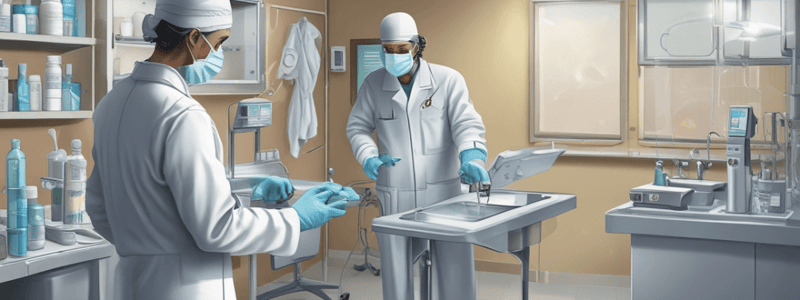Podcast
Questions and Answers
What is an essential step to take before assisting a patient with ROM exercises?
What is an essential step to take before assisting a patient with ROM exercises?
- Explaining the procedure to the patient (correct)
- Performing the exercises quickly
- Checking the patient's vital signs
- Avoiding explaining to the patient
Why is it important to use good body mechanics when assisting patients with ROM exercises?
Why is it important to use good body mechanics when assisting patients with ROM exercises?
- To make the exercises more difficult
- To save energy and prevent injury (correct)
- To tire the patient quickly
- To increase the risk of strain
What is a crucial guideline to follow when beginning ROM exercises with a patient?
What is a crucial guideline to follow when beginning ROM exercises with a patient?
- Move each joint through its normal ROM until feeling resistance (correct)
- Use jerky movements to make it more challenging
- Start abruptly and move quickly through the exercises
- Ignore any pain or muscle spasms experienced by the patient
Why should you avoid overexerting patients during ROM exercises?
Why should you avoid overexerting patients during ROM exercises?
What should be done if a patient experiences pain or muscle spasms during ROM exercises?
What should be done if a patient experiences pain or muscle spasms during ROM exercises?
Why is it important to follow the provider's orders and understand the patient's diagnosis before engaging in ROM exercises?
Why is it important to follow the provider's orders and understand the patient's diagnosis before engaging in ROM exercises?
What should be reported to the nurse or physician immediately if observed in a patient?
What should be reported to the nurse or physician immediately if observed in a patient?
How is a patient's level of consciousness commonly tested to assess orientation?
How is a patient's level of consciousness commonly tested to assess orientation?
In the recovery room, what should be checked every 15 minutes as part of routine monitoring?
In the recovery room, what should be checked every 15 minutes as part of routine monitoring?
What precaution is important to take to protect patients in the recovery room from potential harm?
What precaution is important to take to protect patients in the recovery room from potential harm?
Why is it crucial not to ignore patients in the recovery room even if they seem well?
Why is it crucial not to ignore patients in the recovery room even if they seem well?
What can cause a sudden drop in blood pressure in patients in the recovery room?
What can cause a sudden drop in blood pressure in patients in the recovery room?
What should be done prior to cleaning the pin and the surrounding site?
What should be done prior to cleaning the pin and the surrounding site?
What is a general rule when cleansing the pin sites?
What is a general rule when cleansing the pin sites?
What is an important step after removing the crusts at the pin sites?
What is an important step after removing the crusts at the pin sites?
What is a key aspect of preventing infection during pin care?
What is a key aspect of preventing infection during pin care?
Why is it important to gather supplies for a sterile procedure?
Why is it important to gather supplies for a sterile procedure?
What should be done to address potential pressure areas or abrasions?
What should be done to address potential pressure areas or abrasions?
What is the main objective of breathing exercises described in the text?
What is the main objective of breathing exercises described in the text?
Why is it important to turn or change the patients' position every two hours post-surgery?
Why is it important to turn or change the patients' position every two hours post-surgery?
Which postoperative exercise is specifically mentioned for preventing hypostatic pneumonia?
Which postoperative exercise is specifically mentioned for preventing hypostatic pneumonia?
What is the purpose of practicing turning, coughing, and deep-breathing exercises (TC&DB) before surgery according to the text?
What is the purpose of practicing turning, coughing, and deep-breathing exercises (TC&DB) before surgery according to the text?
How do deep-breathing exercises contribute to preventing postoperative conditions like atelectasis and pneumonia?
How do deep-breathing exercises contribute to preventing postoperative conditions like atelectasis and pneumonia?
Why are blow bottles and incentive spirometry commonly used in postoperative or prolonged bed-rest exercise programs?
Why are blow bottles and incentive spirometry commonly used in postoperative or prolonged bed-rest exercise programs?
What is the recommended frequency for the patient to perform leg and foot exercises before surgery?
What is the recommended frequency for the patient to perform leg and foot exercises before surgery?
Which of the following leg and foot exercises involves lying on your side?
Which of the following leg and foot exercises involves lying on your side?
What is the purpose of leg and foot exercises before surgery?
What is the purpose of leg and foot exercises before surgery?
In addition to maintaining circulation, what is another benefit of performing leg and foot exercises before surgery?
In addition to maintaining circulation, what is another benefit of performing leg and foot exercises before surgery?
Why is it important to change or turn the patient's position regularly before surgery?
Why is it important to change or turn the patient's position regularly before surgery?
Flashcards are hidden until you start studying




